
As I was randomly going through youtube clips a few days ago, I came across the above video of a group of Sikh children in Fremont, who learn kirtan in classical raags. Despite the poor audio, its obvious that they are good and I know this also from having heard them (and some of their contemporaries) in person – they are GOOD.
A couple of weeks ago Jodha reported on an article that brought to light the fact that Sikh children are practicing the tradition of kirtan, but what I think we didn’t discuss there is how this generation of Sikh musicians has really become one of classical musicians, learning stringed instruments of old and performing keertan in the Classical or raag framework. The growth has been obvious, especially in recent years – with the rise of institutions such as the The Raj Academy in Great Britain and the Gurmat Sangeet Department at Punjabi University Patiala, which specialize in providing instruction in traditional (classical) kirtan, and even the Miri Piri Academy in Amritsar of which the Chardi Kala Jatha (classically trained professional Sikh musicians who happen to be American in nationality) is a product.
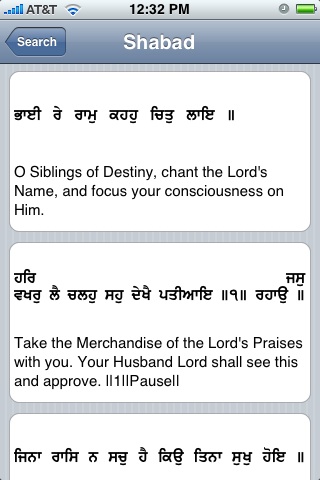 A new Gurbani search engine has become available for Mac users on their i-paraphernalia [hat tip, Sikhnet]. SikhiToTheMax debuted a PC-compatible version a while ago, but now Mac users can also search through SGGS Ji, Dasam Granth, and portions of Bhai Gurdas Vaar on iPhone/Touch. Not having to jailbreak your hardware is a pretty sweet incentive.
A new Gurbani search engine has become available for Mac users on their i-paraphernalia [hat tip, Sikhnet]. SikhiToTheMax debuted a PC-compatible version a while ago, but now Mac users can also search through SGGS Ji, Dasam Granth, and portions of Bhai Gurdas Vaar on iPhone/Touch. Not having to jailbreak your hardware is a pretty sweet incentive.
If you’d like to help the iSikhi team continue to develop the product (or would like to help them finance its development), see below. The app is downloadable at http://www.isikhi.com.
Announcement from iSikhi.com: … the ice is broken and iSikhi is now available.
We’re already working on the next version with punjabi keyboard support that is ready for submission. We would really appreciate your feedback, suggestions, and support at our forums on iSikhi.com.
Donations are welcome as well and will be used to support the iSikhi project. Thanks – iSikhi Team
This past weekend at the Toronto Sikh Retreat a workshop was offered on Guru Tegh Bahadur Ji. I personally think it’s great when we are given the opportunity to delve into the lives of our Gurus. We get to see Sikhi come alive through history. Our Gurus become real as we learn about Sikh principles through their life experiences. No longer are they just pictures on the walls or names to memorize, but perfect humans who overcame personal and communal challenges. Their strong convictions and stead-fast adherence to the values of humility, patience, justice, and equality during difficult times highlights the strength of Sikhi as a practical religion than just a “philosophy”. I hope more conferences and retreats will take this approach.
During the retreat Guru Tegh Bahadur Ji’s life and bani was discussed by participants. As a young boy he was taught by Bhai Buddha Ji and Bhai Gurdas Ji. The former taught him archery and horsemanship, while the latter focused on ancient classics. Thus, Guruji was both a fighter and intellectual that had a deep appreciation for music along with the sword. The Mahima Prakash says: “Sri Tegh Bahadur was the summit of knowledge. He was a recluse at heart, a king in demour. His patience was unmatched, so was his generosity.”
Deh Shiva bar mohe ihe / shubh karman the khabhu na taro
God, grant me this: that I will never refrain from righteous actsna daroo ar siyoo jab jah laro / nische kar apni jeet karo
That I will fight life’s battles without fear, and will claim victory with courageAr Sikh hao apne hi mum ko / Eh lalch hou guna tau uchroo
That you will be ingrained in my mind / with my highest ambition to sing your praisesJab aav ki audh nidhaan nane / aut hee rann me tab joojh maroo
when this mortal life comes to an end, may I fight with limitless courage
“Deh Shiva” is often described as the Sikh national anthem, and it comes to us from Dasam Granth. As a shabad, it has been invoked on the (literal) battlefield as a rallying cry and a unifying call around Waheguru. The shabad analogizes the struggle in our daily lives to overcome issues that lead us away from Waheguru to a battle — with a single-minded focus on Waheguru, we are able to transcend our attachments to the material and emotional trappings of life.
But as a shabad it has also been used in a very literal manner to mobilize Sikhs in war. As Mewa Singh mobilize action around a political (and militarized) struggle. Does a literal intepretation, or recitation, of shabad convert its meaning? I’ve always found this specific shabad empowering and elevating, but not inherently “violent” or “militant.” As a child, I always felt strangely calm and elated by the words, punctuated at each phrase with “Bole So Nihal, Sat Sri Akal!” I have always heard this shabad as a call to the nation, not as a device or tool for violence.
We’ve heard the arguments (valid and not) before about why Sikhi is a martial faith or has a martial history or a martial outlook. There are certainly religious foundations that acknowledge the real challenges faced in every day life and the need to resist oppression. Resistance eschews, but does not forbid, violence. Nonetheless, at its core I believe Sikhi is a religion of love — love of the Guru, Granth, and community, defined in the context of humankind and creation.
The elections are over, but even after the last card has been punched and the last absentee ballot counted, the political fervor that they ignited is still alive. While the country took two steps forward on its march towards complete civil rights by electing its first African American president , it took a step back by taking away the rights of particular individuals. California’s Prop. 8 received national attention (no surprise with more than $70 million in campaign spending). The proposition reversed a ruling from the California Supreme Court, which earlier this year declared that banning same-sex marriages was discriminatory. Prop. 8 – which passed albeit by a hair – will for the time being change the state constitution to define marriage as only between a man and a woman.
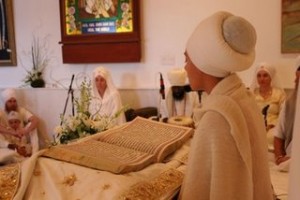 People feel really passionate about this topic. Really really passionate. What interests me the most, however, are the arguments for and against same-sex marriages and particularly what it does or does not say in the Sri Guru Granth Sahib about this topic. People are actually using words from the Sri Guru Granth Sahib to make their point – and I’m not sure that’s legit. In fact, I’ve been following a heated discussion on a certain social networking site where young Sikh individuals have been going back and forth about what voting for or against Prop. 8 means. The most common argument against same-sex marriages is that in the Sri Guru Granth Sahib it states that marriage is the union of two souls, husband and wife, man and woman, male and female. The other side of the argument is that Sikhi advocates equal rights for all and the Sri Guru Granth Sahib does not specifically make any comment on same-sex marriages. However, there seems to be a lot of ambiguity as to what is actually said. One reference states,
People feel really passionate about this topic. Really really passionate. What interests me the most, however, are the arguments for and against same-sex marriages and particularly what it does or does not say in the Sri Guru Granth Sahib about this topic. People are actually using words from the Sri Guru Granth Sahib to make their point – and I’m not sure that’s legit. In fact, I’ve been following a heated discussion on a certain social networking site where young Sikh individuals have been going back and forth about what voting for or against Prop. 8 means. The most common argument against same-sex marriages is that in the Sri Guru Granth Sahib it states that marriage is the union of two souls, husband and wife, man and woman, male and female. The other side of the argument is that Sikhi advocates equal rights for all and the Sri Guru Granth Sahib does not specifically make any comment on same-sex marriages. However, there seems to be a lot of ambiguity as to what is actually said. One reference states,
[The Sri Guru Granth Sahib] is seemingly silent on the subject of homosexuality; however, married life is encouraged time and time again in Guru Granth Sahib Ji. Whenever marriage is mentioned, it is always in reference to a man and a woman. Some Sikhs believe that Guru Granth Sahib Ji is the complete guide to life, and if a marriage between two of the same sexes is not mentioned, it is therefore not right. The counterargument to this is that man and woman are only mentioned in this way to give light to the relationship of the soul and the soul force as being one. This denies gender and sex as an issue. Thus, Sikhism is more concerned with ones attainment of enlightenment rather than habitual desires such as sexuality. True love is attained through the Guru and no man speaks on behalf of the Guru as the Granth is open to interpretation and misrepresentation. [Link]
Some ideas are just better communicated through modes other than writing. Theatre, through the unfolding of a story and through the body language of its actors, can sometimes convey meaning and ideas more effectively than just written words alone.
Some Sikh youth from Rockland, MD have decided to use theatre to engage non-Sikhs in learning about Sikhs- a wonderful idea.
Two plays are being planned for the fall expressing themes of diversity, mutual respect, interfaith and justice. They will both be staged on Saturday December 13, 2008 at the Wooten High School in Rockville, Maryland.
Where did this idea come from?
Last fall, Guru Gobind Singh Foundation had some of its kids take part in a play The Lorax, a musical adaptation from the famous Dr Seuss story book which was staged by kids from many different faiths. This play, adopted to create awareness about environment, was coordinated by the Interfaith Conference of Metropolitan Washington and was staged by the Children’s Theater Company of New York.
After going through this experience, GGSF decided to form the Rockville Chapter of Children’s Theater Company last May to explore the possibility of staging a play depicting the concepts of Guru Granth Sahib. Dedicated to “Building Character Onstage”, the Children’s Theatre Company (CTC) of New York develops in children and youth a keen sense of citizenship while introducing them to the incomparable magic of theatre through their full participation in the creation and performance of musicals and plays. [link]
Update: wow, I did an AWFUL job of summarizing SRI’s first webinar. (Apologies to the good folks at SRI) Here’s a better summary:
Sikh Theology – A Gurmat Framework: The first session comprised of introducing an approach to Sikhi and recognizing how Guru Nanak Sahib revolutionarily delivered a message of Oneness through illustrating a direct connection between ideas and practice. We engaged in understanding what ‘Guru’ means in the Sikh context and how we can begin to comprehend the Guru’s wisdom, Gurmat. To develop this understanding, three facets of bani (scripture), tavarikh (history) and rahit (lifestyle) were introduced. The greatness of a religion is when harmonious balance between Ultimate reality and visible form is exemplified thru the aforesaid facets. We concluded with Puran Singh’s rendering on the Guru’s vision, “It sweetens you and your sweetness sweetens all life around. At your sight, the lamb and the tiger must drink at the same pool.”
And some info on session 2:
Bani – The Message: In session two, we continued to build on our understanding of the Guru’s message; We engaged in actively learning about the scriptural canon, the Guru Granth Sahib. In covering topics as the compilation, contributors, structure, language and content of Guru Granth Sahib, we tackled questions such as, “How do we know Guru Granth Sahib is the Guru?” and “What is the Sabad Guru?”; thus, facilitating and inspiring us to continue to build our personal relationship with Guru Granth Sahib.
And 3:
Tavarikh – The Revolution: Having concentrated on the written form of our Guru’s message (Bani) last week, this week in session three, “Tavarikh – The Revolution”, we will turn our focus on to how our Gurus exemplified The Message. We will walk through the lives of Guru Nanak Sahib through Guru Gobind Singh Sahib and try to understand them through a social, political, economic and spiritual framework. We will cover a range of issues, from touching on the ramifications of negating the need of a Divine intermediary, to the economic center created by the Guru Sahibs, to the activism of both social and political kind. In surveying the inspiring history of our Gurus, we hope to remind ourselves of how relevant, active and exemplary the revolution of Sikh? is.
Over the past few years the website Sikhitothemax.com has become one of the premier tools for English-fluent Sikh youth to access their Guru Granth Sahib. While STTM has problems that can be addressed at another time, it is important to realize the effect that this tool has had. 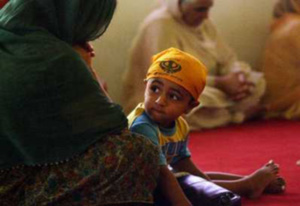 Many Gurdwaras throughout the world have added STTM translations as part of their regular programs and the projection system in the Gurdwara is fast becoming the norm.
Many Gurdwaras throughout the world have added STTM translations as part of their regular programs and the projection system in the Gurdwara is fast becoming the norm.
But is it enough?
In a recent article in the Fresno Bee, reporter Vanessa Colon looks at the question of “losing tradition in translation.”
Colon interviews a number of Central Valley Sikhs and finds that the Sikh youth are often not engaged with their Gurdwara. Although there a number of reasons, she delves into the question of language first and foremost. Some local Fresno Sikhs blamed the Sikh youth for not learning enough Punjabi. However, I see that this approach has problematic for there are now a number of Punjabi/Khalsa schools in California and beyond. However, instruction one day a week for an hour will not ever provide a sufficient language base for one to understand Gurbani.
While exploring the Sikh blogistan, I came across this link from Sikhswim (Thanks Savraj!) and wanted to share it with the rest of the Langar-ites.
Late last year, November 2007, a Sikh Seattle taxi-driver, Sukhvir Singh was brutally attacked by a drunken Luis Vazquez. Luis had been placed in Sukhvir’s taxi by two police officers, after he had been denied entry into Husky Stadium for public drunkenness and alcohol-induced bellicose behavior.
The story may have ended with the sentencing of Luis Vazquez, but it doesn’t. The story is also about the Sukhvir’s courage, faith, and forgiveness. Sukhvir was the vehicle for Waheguru’s forgiveness. Luis has been given another opportunity. The video is a bit extended, but well worth the watch.
Reflection for Monday by Guru Nanak from SGGS (p. 223) in Raag Gauri:
Khima Gahi Brath Seel Santokh
Extending forgiveness is the (true) fast, (the true act of) kindness, (the true path of) contentment
Sharon Stone’s recent comments about whether or not the earthquake in China was due to bad karma over Beijing’s occupation of Tibet has caused quite a stir. Stone is now facing a backlash in China with her films being boycotted (Um, what films?) and luxury retailer Christian Dior pulling advertisements featuring Sharon Stone from stores. The Chinese earthquake killed at least 68,000 people. China has been under much scrutiny in recent months over Beijing’s policies in Tibet. “I thought, is that karma – when you’re not nice that the bad things happen to you?” she mused at the Cannes Film Festival. However, many people feel that Stone’s contextual use of Karma is simplistic and in fact, inaccurate (the actress later apologized for her remarks).
Karma is an important concept for Buddhists, Hindus and Sikhs. Translated from the Sanskrit, it means simply “action”. Because karma is used in a number of ways and contexts this can be confusing…Stone’s take on karma is common – glossed over as an outcome that is the result of something done in the past – or even a past life. But the law of karma states that it’s the motive behind one’s actions that affects the outcome of that particular act. “The earthquake in China or the cyclone in Burma have much to do with environmental factors,” says Dhammadassin. “To invoke karma is more to do with our desire to nail things down and find someone to blame. But that’s not ours to do.” [Link]
So, it got me to thinking about what Sikhi says about Karma. Sikhs use the term generously (and sometimes, not so generously) but perhaps we don’t have a solid understanding of what it really means. The doctrine of karma, according to Sikh belief, is a part of the Divine law (hukam). “The whole universe,” says Guru Arjan, Nanak V, “is bound by action, good or bad” (GG, 51). Guru Nanak declares in the Japji that “all forms, beings, greatness and lowliness, pain and pleasure, bounties and wanderings are subject to the indescribable hukam and there is nothing outside the realm of hukam,” (GG, 1) and then adds that “karma determines the kapra, i.e. body or birth we receive and that it is through nadar (God’s grace) that one secures the threshold of moksa” (GG, 2). [Link]
Do you believe in Karma?
A few weeks ago, I attended a seminar at the Bradshaw Gurdwara (Sacramento) on the dasam granth. Although I was unfortunately unable to attend the entire conference, I was able to listen to Dr. Harpal Singh Pannu, Professor and Head of the Department of Religious Studies at Punjabi University, Patiala. Dr. Pannu provides the intellectual content for those that argue of the authenticity of the entire dasam granth and I was delighted to be able to listen to his address.
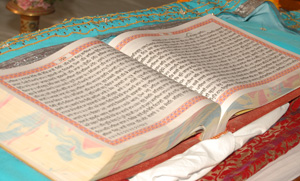 While the conference had a sizable attendance, I left the conference wondering. In this year that we will be celebrating the 300th Anniversary of the Gurgaddi of our everlasting Guru – the Guru Granth Sahib and the Guru Khalsa Panth, why are we wasting time debating about the dasam granth? Where are the conferences about the Guru Granth Sahib?
While the conference had a sizable attendance, I left the conference wondering. In this year that we will be celebrating the 300th Anniversary of the Gurgaddi of our everlasting Guru – the Guru Granth Sahib and the Guru Khalsa Panth, why are we wasting time debating about the dasam granth? Where are the conferences about the Guru Granth Sahib?
Why are we dividing our community on the basis of another scripture? The brilliance of the framers of the Panthic Sikh Rehat Maryada becomes especially apparent.
The Panthic Sikh Rehat Maryada was a TRULY collective effort in the spirit of the Sarbat Khalsa. It took over 15 years of participation, collaboration, and discussion. The drafting of this document may in fact be one of the greatest Sikh historical movements in the post-Guru period. Although presented over 50 years ago, with the exception of the time-period’s gendered language, the document retains its brilliance. Hopefully we can be worthy of our ancestors and use the same process to update its language.
Over 70 organizations collaborated in the creation of the Panthic Rehat Maryada. Before the age of airplane travel, even the Sikhs in the United States (not to mention other Sikh communities in Burma, South East Asia, etc.) gave their opinion and weighed in. The Pacific Coast Khalsa Diwan, Stockton (America) is a proud signatory to the Panthic Rehat Maryada.

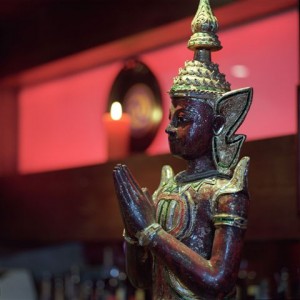 Karma is an important concept for Buddhists, Hindus and Sikhs. Translated from the Sanskrit, it means simply “action”. Because karma is used in a number of ways and contexts this can be confusing…Stone’s take on karma is common – glossed over as an outcome that is the result of something done in the past – or even a past life. But the law of karma states that it’s the motive behind one’s actions that affects the outcome of that particular act. “The earthquake in China or the cyclone in Burma have much to do with environmental factors,” says Dhammadassin. “To invoke karma is more to do with our desire to nail things down and find someone to blame. But that’s not ours to do.” [
Karma is an important concept for Buddhists, Hindus and Sikhs. Translated from the Sanskrit, it means simply “action”. Because karma is used in a number of ways and contexts this can be confusing…Stone’s take on karma is common – glossed over as an outcome that is the result of something done in the past – or even a past life. But the law of karma states that it’s the motive behind one’s actions that affects the outcome of that particular act. “The earthquake in China or the cyclone in Burma have much to do with environmental factors,” says Dhammadassin. “To invoke karma is more to do with our desire to nail things down and find someone to blame. But that’s not ours to do.” [